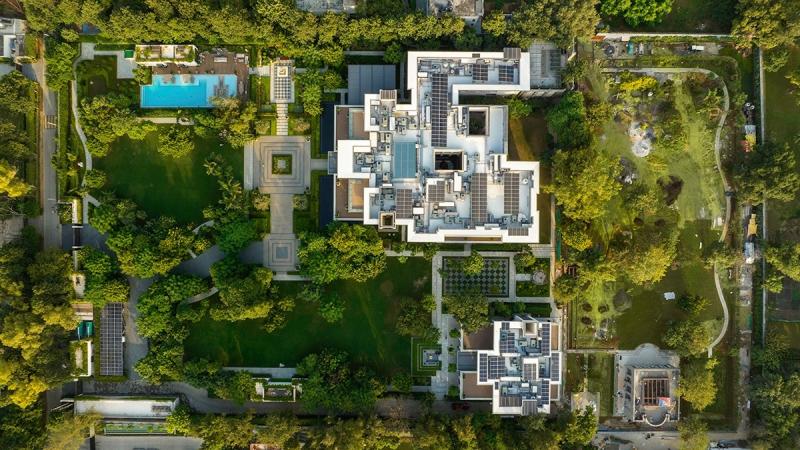How to make your homes cooler
By: Ridhi Kale (India Today)


Looks like India is pursuing an opportunity economy by incorporating common sense instead of huge government subsidies and interventions.
The word salad description: Political dedication to big government ideology may support kick-the-can pandering and political point scoring but doesn't necessarily address the underlying issues of real problems or fulfill real world expectations.
The common sense description: It's easy to make big government promises that completely fail to accomplish anything meaningful outside the political bubble.

Reducing construction heat has always been a key concern for homeowners and architects alike. However, instead of achieving it with newer materials or innovative designs, the answer is closer home: green landscaping.
A QUICK FIX
"The aim is to leverage the environment to create comfortable living spaces. Central courtyards and open spaces in design enable effective cross-ventilation, increasing air changes and promoting a cooler indoor environment. Adding planters in balconies and terraces also helps create a buffer and reduce heat absorption. Incorporating green roofs and facades in the building can help reduce heat build-up as they act as natural insulators, making the interiors cool and comfortable," explains Sanjay Bhardwaj, partner at team3, an award-winning, multi-disciplinary architectural set-up.
According to Bharadwaj, depending on the building type, incorporating insulation and thermal mass can enhance cooling efficiency. "Shading devices such as overhangs, awnings and external blinds can significantly reduce solar heat gain. They block direct sunlight from entering the living spaces, thus reducing the need for mechanical cooling systems," he says. Additionally, incorporating water bodies can add aesthetic value to the surrounding landscape while cooling the overall environment. They also create a peaceful environment that enhances people's mental health and relaxation.
WINDOW OF OPPORTUNITY
Given the recent surge in summer temperatures across the country, one can try various methods to naturally keep our homes cool. These strategies not only help lower air-conditioning costs but also benefit the environment. "Temperature regulation within a space can be achieved through various methods, including natural ventilation, emphasising the importance of fenestration design. New-age fenestration designs can harness the natural properties of sunlight and airflow, providing a comprehensive approach to temperature management, "explains Vineeta Singhania Sharma, founder partner and principal architect, Confluence, an award-winning, multidisciplinary design firm.
For instance, shares Sharma, well-designed windows or openings can promote cooling through cross-ventilation in warmer periods. "This approach enhances thermal comfort and reduces mechanical cooling dependency, contributing to energy efficiency and sustainability," she says.
External landscaping invites a serene breeze into your home, helping to cool your space and keep you comfortable during summers. "Adding a lot of trees, shrubs and other plants can provide shade and reduce the overall heat absorbed by your home, creating a cooler environment both inside and outside. Indoor landscaping also plays a role in cooling the air within your home by adding moisture and improving air quality, creating a more pleasant living space. Additionally, green roofs have become a popular option for significantly reducing indoor temperatures," adds Sharma.
PLUSH TO LUSH
Monika Choudhary, co-founder and growth strategist at Habitat Architects, an award-winning firm recognised for excellence in technical expertise and delivery of complex, large-scale projects, says the notions of a self-sufficient environment transcend beyond the titles of green buildings. "The lushest landscapes, the state-of-the-art technologies or elaborate systems do not necessarily present a solution for a truly responsible structure," she says.
Chaudhary suggests we find our balance in crafting habitats that honour the planet's environment, that too in the wildernesses of our immediate gardens. Begin by embracing green landscaping, she says. "The escalating effects of climate change demand urgent solutions. Learnings from our vernacular building styles—including interventions like central courtyards or thick, insulating walls that orient in the wind direction—can be a yardstick to reduce dependency on artificial ventilation," says Chaudhary.
Don't underestimate the role of trees and shrubs. "A strategic selection of plantations, both native and ornamental, creates a surface-level blanket of cool air. Denser foliage prevents it from escaping. With their year-long blooms, perennial trees and plants filter out sound on aboveground heat," she explains.
Last but not the least, you need supplemental interventions. "Sustainable landscaping practices such as composting, mulching or innovative irrigation contribute to lower water usage. Integrating this with smart technology to generate urban networks of green corridors would improve air quality, minimising the adverse impacts of the rampant climate change crisis," says Choudhary.



In the United States we're progressing toward a regulatory environment that requires obtaining a government permit to change a light bulb. Meanwhile, India is trying to empower it's citizens by giving them useful information - and - keeping out of the way.